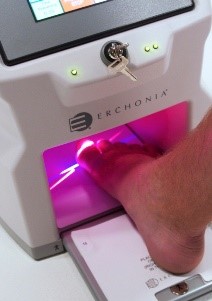Fungal nail therapy is a treatment to treat nail fungus, most commonly found on the nails of the foot. Foot fungus is usually first noticed by the toenails looking a little bit different to normal. The appearance of foot fungus may be mild at first so can go unnoticed, particularly if you are in the habit of wearing nail polish. Eventually, the nail will become thickened and discoloured. The colour of nail fungus can vary ranging from white to brown with typical yellowing or orange colours occurring. In more advanced cases of nail fungus complications such as ingrown toenails and corns may form around the nails. The fungus can also attract tinea which is particularly dangerous in patients who already have diabetes, leg ulcers or peripheral arterial disease.
The cause of foot fungus is varied. Often foot fungus is the result of damage to the nail allowing the fungus to creep in. Athletes damaging their toenails during sport are particularly prone to this type of fungus – sometimes referred to as athlete’s foot. The culprits behind foot fungus are usually dermatophytes, candida, yeasts and moulds that thrive in the damp, warm environment of a closed in shoe. There are some conditions that make a person more susceptible to foot fungus including diabetes, psoriasis, a weakened immune system or generally poor health. Nail-biting and smoking are also thought to increase the risk of foot fungus as is poor hygiene, especially in shared bathroom facilities.
Obviously, fungal nail infections can not be left to just resolve themselves and will require treatment to fix the problem. Most people turn to home remedies first rather than going to see a podiatrist straight away at a foot and nail clinic. The problem with home treatment is the type of fungus is not properly diagnosed so treatment plans follow a method of trial and error. Topical at-home treatments for foot fungus bought from the chemist can work in mild cases and in otherwise healthy people. Many people do seek medical help and visit a doctor as their first port of call instead of going to see a podiatrist at a foot fungus clinic straight away. A doctor may suggest topical treatments or oral medication. Oral medication can be effective, however, it has side effects and can damage the liver if used long term. Many doctors will refer you to a podiatrist at a foot and nail clinic because they understand fungal nail therapy will be needed over a long period of time. This is especially the case with diabetics who are very prone to foot fungus and need continuous fungal nail treatment. Note: you do not actually need a doctor’s referral to visit a podiatrist unless the visit is part of a health care plan. You can contact your podiatrist directly to make an appointment.
Podiatrists have a number of treatment options available to them to treat foot fungus. Before they treat your nail your podiatrist will first diagnose the type of fungus you have through an examination and samples taken from your nail or nail bed. These samples will be sent to the lab for analysis. With the results back, your podiatrist can then choose the best treatment option.
Treatment options from your podiatrist may include trimming the fungus off your nail in conjunction with antifungal drugs applied either topically or orally. Surgery to remove the nail may be recommended if the fungal nail infection is in your nail bed. Removing the nail allows access to the nail bed for topical treatments. Your nail will regrow but with this type of nail therapy, there is always the possibility the infection will return. Another treatment option is the thermal laser. This type of laser fungal nail therapy is very effective. However, not all patients can tolerate the heat from the thermal laser, limiting treatment options.
A relatively new treatment for foot fungus found at foot and nail clinics is a cold form of laser fungal nail therapy. Lunula lasers are at the forefront of this technology. Their lasers operate at a lower wavelength than thermal lasers so they do not generate heat and pain for the patients. The cold laser has an antimicrobial and antifungal effect. The wavelength also encourages tissue regeneration and blood flow, accelerating clear nail growth.
The advantages of lunula laser fungal nail treatment are:
⦁ No pain
⦁ No chance of developing microbial resistance
⦁ No interactions with any medication
⦁ No chance for liver toxicity
⦁ Treats the entire nail bed, plate and surrounding skin
Typically around 2-4 treatments are required at a foot and nail clinic, with more severe cases of foot fungus requiring more.
Patients on the Sunshine Coast are fortunate to have Lunula laser therapy available to them as its availability is currently very limited due to the high cost of the equipment. Our Sunshine Coast patients can access lunula laser fungal nail therapy through Suncoast Podiatry at any of our Sunshine Coast clinics, including Bli Bli, Gympie, Cooroy and Noosa on the north of the Sunshine Coast.
If you are experiencing problems with foot fungus we are the people to help you.
To make an appointment simply fill in the online booking form to request an appointment
https://www.suncoastpodiatry.com.au/book-appointment/

